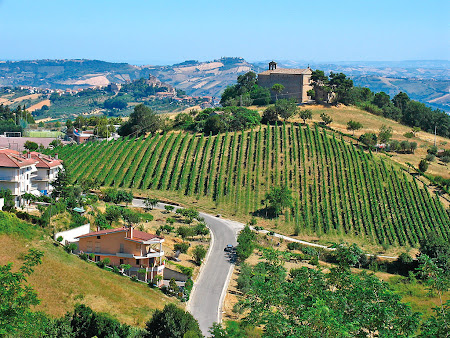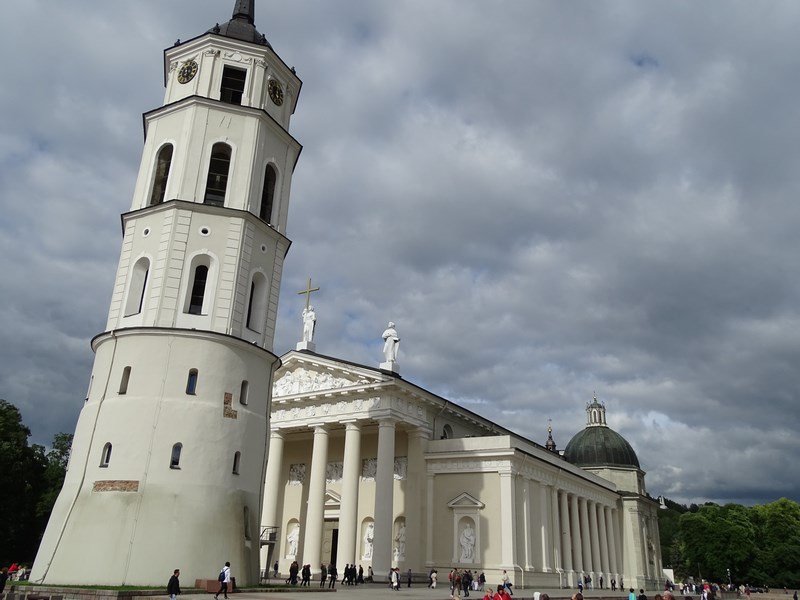Carpatair Destinations: Ancona, discover the Adriatic Coast ! Part 1
Today, we continue to publish the presentation of some Carpatair destinations and we will focus on a lesser visited city of Ancona. Ancona is probably not on the usual tourist trail, but I hope you will disover some interesting spots which are worth discovering !
The paralyzing silence felt from the distance will however prove just a trick of Ancona, its means of attracting travelers, as soon as they have docked into its harbor, because the city reveals itself as a cheerful and kind place, animated by the commotion of docking ships, screeching cranes loading their cargo or multicolored luggage of tourists passing through.
One day in the year 101, Roman Emperor Trajan was about to fulfill his dream, as he was gathering his war fleet in the harbor of Ancona. The idea of expanding the Roman Empire eastwards with yet another province – Dacia – revived his hunger for fights and glory. For his wars against the Dacians, he chose Ancona as the starting point – the safety harbor of many navigators since as early the 16th century B.C.
With its extremely favorable location on the Adriatic coast of the Italic Peninsula, harbored from the fury of high waters by this gulf seemingly created by nature for this purpose, the naval point of Ancona reveals archeological vestiges accounting for its commercial links with Greece since the 13th century B.C. The Dorians – inhabitants of ancient insular Greece – took the opportunity to settle in the area of the Adriatic harbor in 387 B.C. and together with the locals, they founded the town they first called Ankon, which is Greek for ”elbow”. The originality of this name is strictly connected to the geography of this area that has the shape of a bending arm.
The history of the area, the harbor built by Dorians in the Gulf of Ancona and later expanded by the Romans, the sieges and the need to consolidate the harbor in the 9th century with a defense wall describe the trials and tribulations of this naval hub, the very proof of its prosperous activities. During the 13th and 14th centuries, Ancona – the current capital city of the eponymous province and of the Marche region in central Italy – was the second most important harbor on the Adriatic Sea, after Venice. Its subsequent history includes gradual decline – both for the port and the city, as the harbor operations have had a direct impact on the development of the citadel.
Once included into the Papal State in 1532, Ancona got the attention of Pope Clement XII, who, confident in the potential of the Dorian settlement and naval commerce, designed a plan to revive the city in the 18th century. The wish of Pope Clement XII to support the new evolution of Ancona spurred the city development by granting custom tax exemptions, rebuilding the decaying docks and founding the lazaretto. The harbor put on its merchant cape once again, developing to such an extent that, in spite of the violent independence wars and bombardments during the WWII, it was still able to resist and become a genuinely important hub in the Adriatic Sea, currently deemed to be one of the major European ports on a global scale. According to statistics released by the Ancona Port Authorities, 1.5 million passengers and more than 9 tons of cargo passed through Ancona as their arrival or departure point in 2008 – and all these figures were higher than the previous years. This intense naval traffic, as well as the continuously developing fishing operations led the Authorities to focus on the economic potential of this place, in order to debate and implement new projects for the development of this port. Moreover, with the clearing of the northern naval area, the historical harbor will once again become part of the city. As a token of appreciation for Emperor Trajan’s skills in consolidating and developing the harbor and gratitude for the Empire expansion by yet another Roman province, i.e. Dacia, the Senate of Ancona presented him with the triumph arch called Arco di Traiano, built on the seashore in 115. This was designed by the best Roman architect, the Syrian Apollodorus of Damascus – the same who had designed the great bridge across the Danube, used in the process of conquering Dacia.
Made of Turkish marble, the arch was adorned with the statues of the Emperor, his wife Plotina, and his sister Ulpia Marciana. The gilded stucco work and bronze statues were stolen in the 9th century. The stairs completing the monument were only built in 1859. Despite all the hardships it had faced for two millennia, Apollodorus’ masterpiece stubbornly resisted, becoming a genuine symbol of Ancona’s longevity as a city.
Also built on the sea shore is the Lazzaretto (Laemocomium or Mole Vanvitelliana), the pentagonal structure built by architect Luigi Vanvitelli in 1732, at the request of Pope Clement XII. With an area of more than 20,000 square meters, it was designed to shelter military troops and their officers, protecting them against the diseases brought from abroad by docking ships. The name of „lazaretto” was only given to it later, when it started functioning as a military hospital and barracks. To honor his activity in Ancona, much like Emperor Trajan, Pope Clement XII was dedicated an arch very similar to the Roman one and only a few steps away from it.
Cathedral of San Ciriaco
You can admire the panorama of the port area from Colle Guasco. However, once you enjoy this view and get curious to find out more about the mysteries of the hill, you will also feel the urge to learn more about this place. The beauty above the sea is a mixture of the architects’ skills, the piety of the place and the kindness of goddess Venus. For this is the game the forefathers of this city first dedicated to her, the goddess of gardens and spring. Ancient poets like Catullus and Juvenal invoke her in their poems, as the protector of the citadel. On top of Venus’ temple, the 8th century also saw the building of a sacred structure in the shape of a Latin cross, on the same spot where in 1128 they started working on the foundation of the present day cathedral of San Ciriaco (completed in 1189). Dedicated to St. Ciriaco, this grey stone church is a grandiose architectural monument, built in a Roman and Gothic style, with a Greek cross-shaped footprint (both axes have the same length and cross in their central point). In the middle of the church, 10 pillars taken from the sanctuary of goddess Venus support the whole construction. Their grandiosity compete with the beauty of the 12th-century mural paintings, the exotic and Byzantine inner elements and the wooden ceiling shaped like a boat turned upside down. The central part of the building, where Pope Pius II found his eternal rest in 1464, is a 12-side dome, built by Margaritone d’Arezzo in 1270.
Access into the Cathedral of San Ciriaco is made through an imposing portal in Gothic style, designed by Giordio da Corno in 1228, with pillars supported by the sculptures of two strong lions. Archways similar to those of the main access way are lining the sides of the building.
Discover the charm of Ancona
With its medieval atmosphere, Ancona reveals priceless churches – proofs of faith, but also locals’ gratitude to the Divinity, for the prosperity of their port city. The church of Santa Maria della Piazza, built in the 13th century in Via della Loggia, surprises with its richly decorated facade, with dozens of rows of marble archways and pillars all along the building from one corner to the other. The simplicity of the inner space, divided by archways, the white walls and its pervading modesty express the purity of Saint Mary. This church was also built on the ruins of an older one, with a glass plaque incorporated into the wall to expose the remnants of the old structure.
In the same street, on the way to Piazza della Republica, you can find one of the most spectacular buildings in the city. As they need to get more space in the process of developing the commercial life of this port city, authorities built a merchant center between 1442 and 1443 – Loggia dei Mercanti. Nowadays, this is the most important edifice in Ancona. It is important thanks to its Gothic Venetian style, with sculptures, statues, paintings and Dalmatian marble, and especially as it bears proof to the most beautiful and prosperous period in the life of the Dorian city. The building was designed by Giorgio da Sebenico (1451-1459) and financed by the locals. Following a fire that destroyed its interior in 1556, it was rebuilt by Pellegrino Pellegrini – called Tibaldi – in 1558-1561. As property of the Chamber of Commerce in Ancona, the building and its fatuous spaces are currently used for commercial purposes. Located in the city downtown, Loggia dei Mercanti is easily accessible either by public transportation or by car, as there is a parking lot right across the street. This great location also allows for the ground floor of Loggia dei Mercanti to be rented – a comfortable and elegant hall that can seat up to 120 people attending conferences, congresses, ceremonies, various meetings and political, economic or cultural events. On the other side of Piazza della Republica, Via Loggia opens onto Piazza del Plebiscito, one of the largest squares, guarded by the statue of Pope Clement XII. Completed in the 15th century, it was at first called Piazza Nuova, then Piazza Grande, Piazza Napoleone during the French occupation, and Piazza San Domenico, like the church standing next to it. It finally received its current name in 1870, when the Marche area was annexed to the Kingdom of Italy. This diversity of names proves the major part played by this square in Ancona along the years. The colored facades of the medieval buildings adorned with stucco works, the narrow streets and the church of San Domenico build an atmosphere of intimacy in this square. Dancers accompanied by flute and horsemen riding their horses are now replaced by cars passing by and locals slowly sipping their afternoon coffee in one of the street restaurants. This is the place that joins together the Prefect Hall (the former Palazzo del Governo) designed by Francesco di Giorgio Martini in 1484, The “Luciano Benincasa” City Library (Palazzo Mengoni-Ferretti), the City Museum, also including the San Tommaso di Canterbury Hospital opened in 1349, three more palaces and two water fountains.
The statue of Pope Clement XII stands in front of the church, as an homage to his support in the development of this city. Social life and night life mostly take part in this historical area of the city, where Teatro delle Muse was opened on February 12, 1819. As the biggest theater in the whole Marche area, Teatro delle Muse hosts symphonic and jazz concerts, ballet and opera performances.
While strolling around the city, you can stop and refresh at Fontana del Calamo. This fountain built in the 16th century on Corso Mazzini includes 13 masks placed in a row and noisily pouring fresh water. If you cannot resist the temptation of the sea, as its fragrance overwhelms the streets, you can head to one of the Ancona beaches. On the central beach of Passetto – typical for a high coast, with a lot of rocks and cliffs – you can find one of the city symbols standing not far away from the shoreline. La Seggiola del Papa, the tall cliff called “The Chair of the Pope” is used by daredevils as a springboard for their spectacular summersaults in the high waters. The Palombina beach, north of the harbor, has a milder relief and therefore sunlight is more intense here. This is a more urban beach, full of life and located next to the railway. Ancona is a vibrant city where annual feasts are accompanied by many other events. Apart from the Carnival, which, due to its common history with old-time Venice, has become a joyful event for the locals, the population of the whole region happily greets the traditional Festa del Mare (The Feast of the Sea), held on the first Sunday in September and reuniting hundreds of boats.
They all start together for the high seas, in memory of those who became victims of the sea, honoring them with a major religious ceremony. On the seashore, people go to shows and concerts, stroll among the stands full of delicacies or visit the ship fair (‘degli Archi’). The climax of the celebrations comes at the end of the day, with an imposing fireworks display above the sea.
The silence of the Ciriaco Cathedral is yet another “victim” of the energetic Ancona temperament. During the first four days of May, the area around it hosts the San Ciriaco Fair, an event whose tradition goes back to the 14th century. The procession in honor of this saint martyr and protector of the citadel is enhanced by everything that goes around in the dozens of stands selling souvenirs and good food, on the way to the sacred place. The time, history and spirit of this place have influenced more than the city of Ancona itself. Much as Loreto, the whole area is full of mysteries, legends and secret corners, as well as sacred or secular places that stand proof for the prosperous life of the province. It is one of the richest areas in Italy in terms of military medieval buildings, castles, towers and defense walls.
The towns on these hills were established back in medieval times, as early as the 12th or 13th century, to be further restored or rebuilt in the 14th or 15th century and adapted to the needs of their communities, but still keeping many of their initial urban elements to this day. This explains why, in Osimo, Jesi and Arcevia, you can still admire the defense walls of the ancient towns, while in Montecarotto, Poggio S. Marcello and Loreto, the 17th century walls provide a defensive system much more complex than the previous ones. Some of the most beautiful fortresscities that overwhelm our soul with their history include Serra de’ Conti, Serra San Quirico, Corinaldo with its grand Porta Nova and Moro d’Alba, with its sheltered alley along the defense wall. We should also notice the nine castles in Arceviva, the fortress of Roveresca in Senigallia and the one in Offagna. Walls that once used to protect locals from invaders have become tourist attractions for travelers who come here to admire their splendor.
The feeling one has here is incredibly intense, surrounded by the silence of the fortresses, only interrupted by the sound of footsteps on the sun-warmed pavement. The charm of urban life in the 21st century within a medieval small town setting will conquer the heart of any visitor.
Sights of Ancona
About Carpatair
Founded in 1999, Carpatair is the largest regional airline in Eastern and South-Eastern Europe. From 2000, Carpatair has developed in Timisoara the most professional HUB in Romania, connecting 7 domestic and 14 international airports. Carpatair operates over 200 flights / week to 21 destinations in 5 countries.

















Hi, i feel that i noticed you visited my web site thus i came to return the prefer?.I’m attempting to to find things to improve my site!I suppose its ok
to make use of a few of your ideas!!